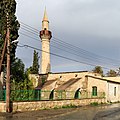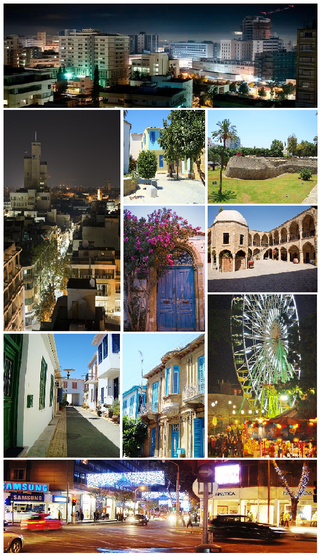
Nicosia is the capital and largest city of Cyprus. It is located near the centre of the Mesaoria plain, on the banks of the River Pedieos.

Mimar Sinan also known as Koca Mi'mâr Sinân Âğâ, was the chief Ottoman architect, engineer, mathematician for sultans Suleiman the Magnificent, Selim II and Murad III. He was responsible for the construction of more than 300 major structures such as the Selimiye Mosque in Edirne, the Kanuni Sultan Suleiman Bridge in Büyükçekmece, the Mehmed Paša Sokolović Bridge in Višegrad, and other more modest projects such as madrasa's, külliye's, bridges, etc. His apprentices would later design the Sultan Ahmed Mosque in Istanbul and Stari Most in Mostar.

The Eyalet of Cyprus was an eyalet (province) of the Ottoman Empire made up of the island of Cyprus, which was annexed into the Empire in 1571. The Ottomans changed the way they administered Cyprus multiple times. It was a sanjak (sub-province) of the Eyalet of the Archipelago from 1670 to 1703, and again from 1784 onwards; a fief of the Grand Vizier ; and again an eyalet for the short period from 1745 to 1748.

The Catholic Church in Cyprus is part of the worldwide Catholic Church, under the spiritual leadership of the Pope in Rome.

The conversion of non-Islamic places of worship into mosques occurred during the life of Muhammad and continued during subsequent Islamic conquests and under historical Muslim rule. Hindu temples, Jain Temples, Christian churches, synagogues, and Zoroastrian fire temples have been converted into mosques.

Hala Sultan Tekke or the Mosque of Umm Haram is a mosque and tekke complex on the west bank of Larnaca Salt Lake, in Larnaca, Cyprus. Umm Haram was the wife of Ubada bin al-Samit, a companion of the Islamic prophet Muhammad, and foster sister of Muhammad's mother, Aminah bint Wahb.
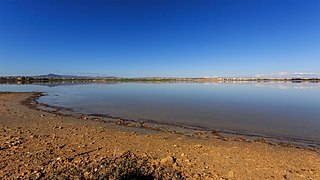
Larnaca Salt Lake is a complex network of four salt lakes of different sizes to the west of the city of Larnaca. The largest is lake Aliki, followed by lake Orphani, lake Soros and lake Spiro. They form the second largest salt lake in Cyprus after the Limassol Salt Lake. The total surface area of the lakes adds up to 2.2 km2 and being just off the road leading to Larnaca International Airport, the lake is one of the most distinctive landmarks of the area. It is considered one of the most important wetlands of Cyprus and it has been declared a Ramsar site, Natura 2000 site, Special Protected Area under the Barcelona Convention and an Important Bird Area (IBA). It is surrounded by halophytic scrubland and on its bank lies the Hala Sultan Tekke, one of the holiest of shrines within Ottoman Islam. It houses the tomb of Umm Haram, Muhammad's 'wet-nurse'.

Piali Pasha was an Ottoman Grand Admiral between 1553 and 1567, and a Vizier (minister) after 1568. He is also known as Piale Pasha in English.

Selimiye Mosque, historically known as Cathedral of Saint Sophia or Ayasofya Mosque, is a former Christian cathedral converted into a mosque, located in North Nicosia. It has historically been the main mosque on the island of Cyprus. The Selimiye Mosque is housed in the largest and oldest surviving Gothic church in Cyprus possibly constructed on the site of an earlier Byzantine church.

The Lala Mustafa Pasha Mosque, originally known as the Cathedral of Saint Nicholas and later as the Saint Sophia (Ayasofya) Mosque of Mağusa, is the largest medieval building in Famagusta, Cyprus. Built between 1298 and c. 1400, it was consecrated as a Catholic cathedral in 1328. The cathedral was converted into a mosque after the Ottoman Empire captured Famagusta in 1571 and it remains a mosque to this day. From 1954 the building has taken its name from Lala Mustafa Pasha, the Grand Vizier of the Ottoman Empire from Sokolovići in Bosnia, who served Murat III and led Ottoman forces against the Venetians in Cyprus.

Lala Mustafa Pasha, also known by the additional epithet Kara, was an Ottoman Bosnian general and Grand Vizier from the Sanjak of Bosnia.
Religion in Cyprus is dominated by Eastern Orthodox branch of Christianity, whose adherents make up 73% of the total population of the entire island. Most Greek Cypriots are members of the autocephalous Greek Orthodox 'Church of Cyprus'. Most Turkish Cypriots are officially Sunni Muslims. There are also Baháʼí, Catholic, Jewish, Protestant, Maronite, Armenian Apostolic, and non-religious communities in Cyprus.

Islam in Georgia was introduced in 654 when an army sent by the Third Caliph of Islam, Uthman, conquered Eastern Georgia and established Muslim rule in Tbilisi. Currently, Muslims constitute approximately 9.9% of the Georgian population. According to other sources, Muslims constitute 10-11% of Georgia's population.

The following outline is provided as an overview of and topical guide to the Ottoman Empire:
This article documents the status of various religions in the limited-recognition state of Northern Cyprus. Turkish Cypriots administer approximately one-third of the island.
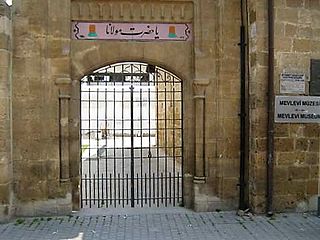
Mevlevi Tekke Museum is a tekke in Nicosia, Cyprus, currently in North Nicosia. It has historically been used by the Mevlevi Order and now serves as a museum. It is one of the most important historical and religious buildings on the island. It is located next to the Kyrenia Gate, on Girne Avenue, in the İbrahimpaşa quarter.

Ömeriye Mosque, is a mosque in the walled city of Nicosia on the island of Cyprus, currently located in the south section of Nicosia. Following the Greek invasion of Cyprus, the mosque gained significance as one of the most important sites of Muslim worship in the non-Muslim section of the island and the city.
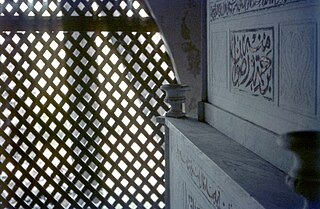
Umm Hiram bint Milhan, was the maternal aunt of the Islamic prophet Muhammad, and one of his companions. She was also one of the Ansar of Medina.
Umm Haram is a female companion of Muhammad.
Adila Khanum was a Turkish woman who was the third spouse of Hussein bin Ali, Sharif of Mecca and then, King of Hejaz between 1916 and 1924.


